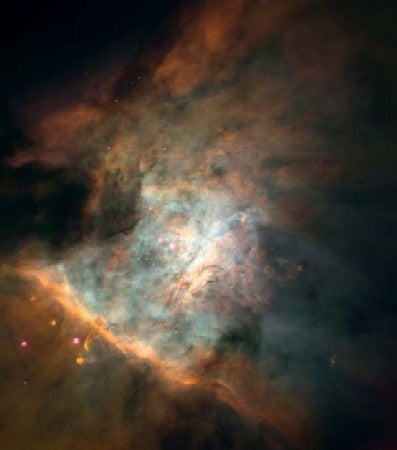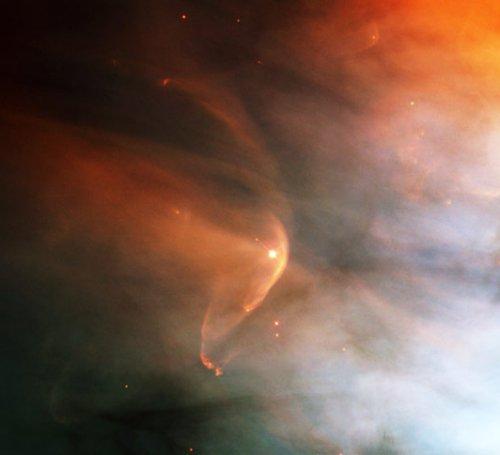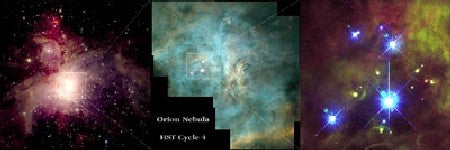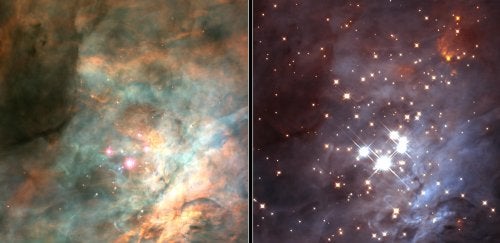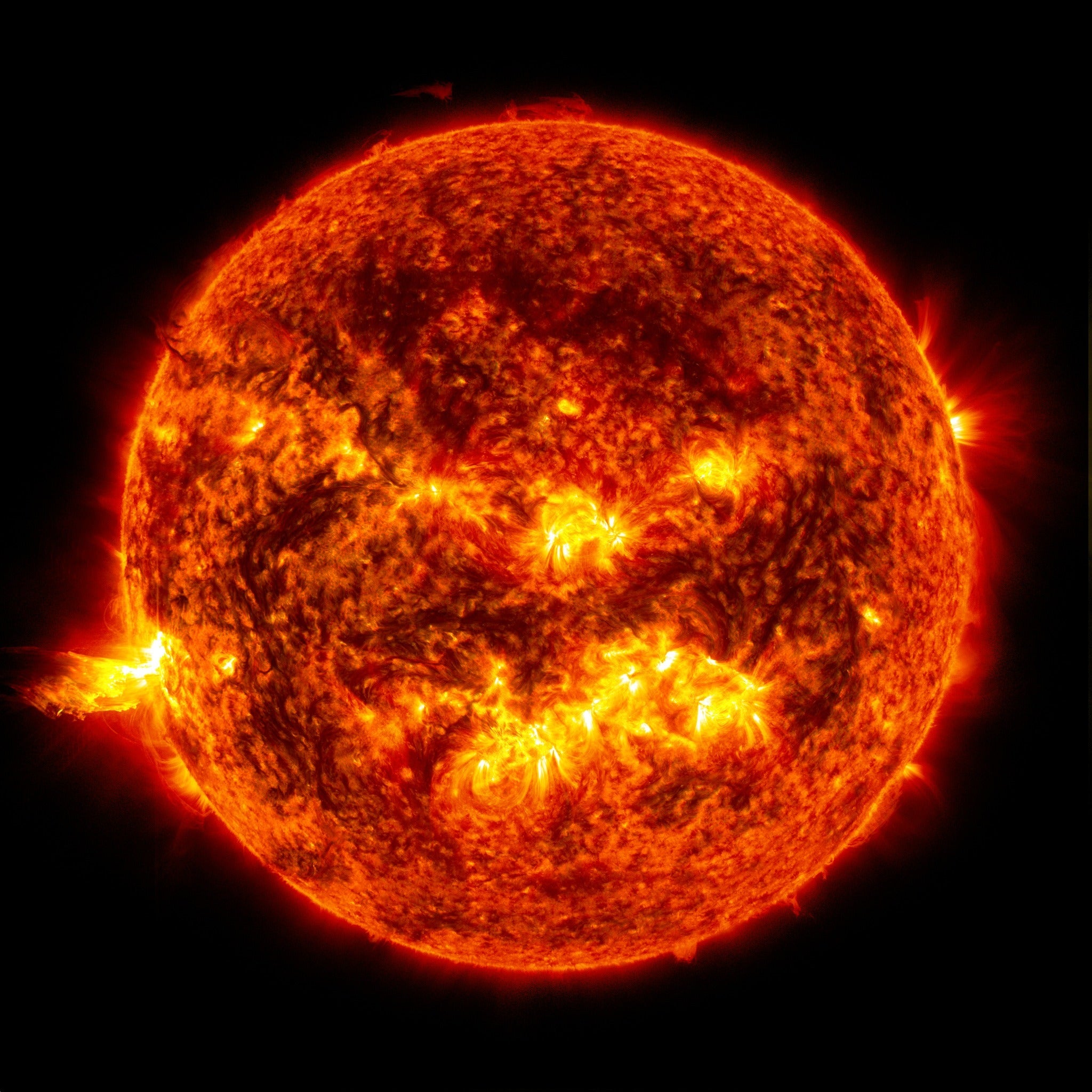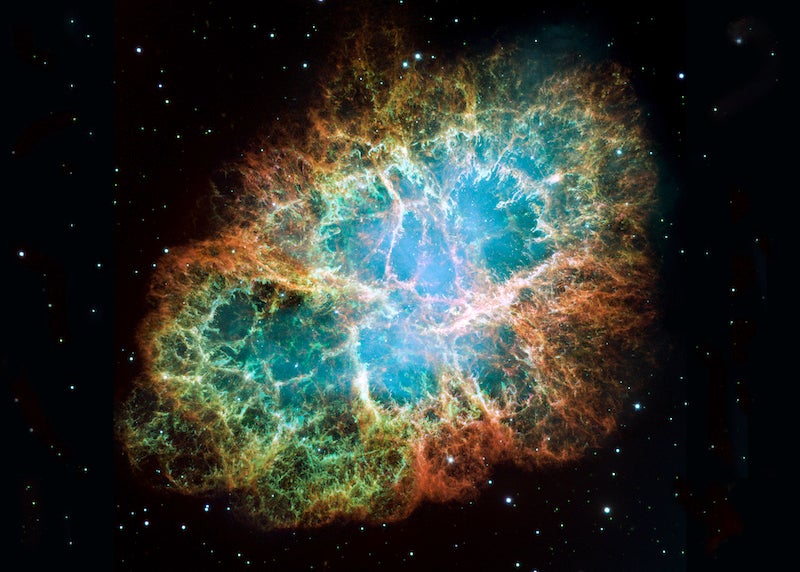When it was launched in 1990, the Hubble Space Telescope had a flaw in its 2.4-meter mirror that prevented it from viewing the universe as astronomers intended. But since its repair in 1993 by spacewalking astronauts, Hubble has captured many magnificent and unforgettable portraits of the universe. One of its most common targets is the famed Orion Nebula. Visible to the naked eye, it is one of the brightest emission nebula in the sky and is a hotbed of star formation containing ionized gas, young stars, and solar systems in the making.
Here are just some of the stunning views Hubble has captured of the Great Nebula in Orion over the past decade.
The Nebula’s Center
This view spans the central 2.5 light-years of the Orion Nebula — just a small portion of the entire structure. It is a mosaic of images taken between January 1994 and March 1995. Details as small as 4.1 billion miles across reveal a churning turbulent star factory set within a maelstrom of flowing, luminescent gas. NASA / C.R. O’Dell and S.K. Wong (Rice University)
Named for the crescent-shaped wave made by a ship as it moves through water, a bow shock can be created in space when two streams of gas collide. LL Ori emits a vigorous solar wind, a stream of charged particles moving rapidly outward from the star. The material in the fast wind from LL Ori collides with slow-moving gas evaporating away from the center of the Orion Nebula, located to the lower right in this image.
NASA and The Hubble Heritage Team (STScI/AURA)
Bow Shock Near a Young Star
Taken February 3, 1995, by the Wide Field Planetary Camera (WFPC), this Hubble Heritage image shows a bow shock around the young star LL Orionis. Named for the crescent-shaped wave made by a ship as it moves through water, a bow shock can be created in space when two streams of gas collide. LL Ori emits a vigorous solar wind, a stream of charged particles moving rapidly outward from the star. The material in the fast wind from LL Ori collides with slow-moving gas evaporating away from the center of the Orion Nebula, located to the lower right in this image. NASA and The Hubble Heritage Team (STScI/AURA)
Taken February 3, 1995, by the Wide Field Planetary Camera (WFPC), this Hubble Heritage image shows a bow shock around the young star LL Orionis. Named for the crescent-shaped wave made by a ship as it moves through water, a bow shock can be created in space when two streams of gas collide. LL Ori emits a vigorous solar wind, a stream of charged particles moving rapidly outward from the star. The material in the fast wind from LL Ori collides with slow-moving gas evaporating away from the center of the Orion Nebula, located to the lower right in this image. NASA and The Hubble Heritage Team (STScI/AURA)
The Trapezium
Orion’s well-known Trapezium includes a young open cluster of stars amidst clouds of gas and dust. The most prominent members are four massive, hot stars represented well in this Hubble image. NASA / HST / John Bally, Dave Devine, and Ralph Sutherland
Orion’s well-known Trapezium includes a young open cluster of stars amidst clouds of gas and dust. The most prominent members are four massive, hot stars represented well in this Hubble image. NASA / HST / John Bally, Dave Devine, and Ralph Sutherland
Visible and Near-infrared Views of the Trapezium
The Hubble Space Telescope’s near-infrared camera uncovered about 50 newborn brown dwarfs in the Trapezium region of the Orion Nebula. These objects and many of the region’s young stars are too dim to be seen in visible exposures. These side-by-side Hubble images compare what the area looks like at visible and infrared wavelengths. NASA / STScI / K.L. Luhman / G. Schneider et al. / C.R. O’Dell / S.K. Wong
The Hubble Space Telescope’s near-infrared camera uncovered about 50 newborn brown dwarfs in the Trapezium region of the Orion Nebula. These objects and many of the region’s young stars are too dim to be seen in visible exposures. These side-by-side Hubble images compare what the area looks like at visible and infrared wavelengths. NASA / STScI / K.L. Luhman / G. Schneider et al. / C.R. O’Dell / S.K. Wong

